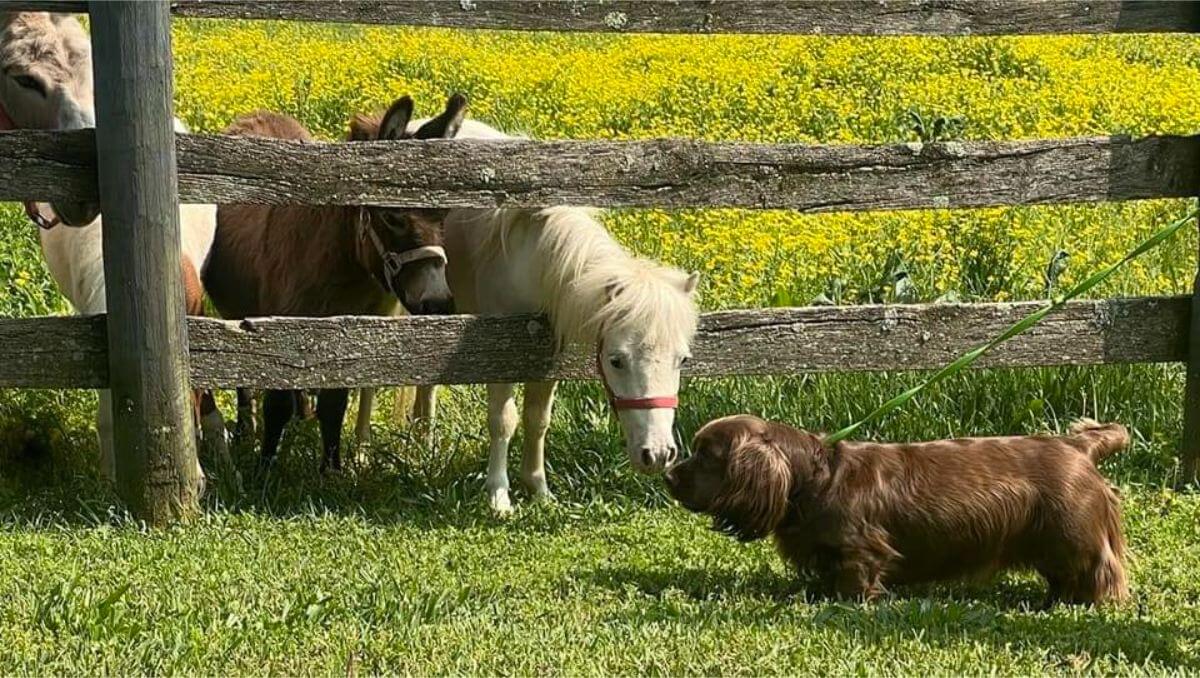


Home » The Sussex Spaniel

This article was originally published in Showsight Magazine, January 2014 issue.
The Sussex Spaniel is one of the most unique in the Sporting Dog group. They are still one of the rarest of the rare breeds, with approximately 600 in number. This has stayed pretty much the same for the past 20 years. This little brown dog, as most breeders refer to them, is long, low, and level. They are exuberant in the field, and their tail action is quite lively when on the scent of a bird. They are slow and methodical, with quartering (back-and-forth movement) covering the entire field. They are the true gentleman’s hunting dog, which simply means they stay close to their master and within gun range.
There are many misconceptions regarding the Sussex Spaniel in the show ring, so we will discuss a few of them in this article. Anyone judging the Sussex (or other Spaniels as well) should be well versed in just what some of the terminology really means and how it relates to that particular breed.
We will start with the Sussex being long, low, and level. They are rectangular, which I believe most judges understand; they are low, 13″-15″ in height, and they should carry a level topline.
Their lively tail action is something you will only see while they are in the field, doing the work for which they were bred. They should have a nice wagging tail in the show ring, but please do not expect “lively” tail action. That tail action comes when they are on scent of a bird and assists their master in identifying where they are by the movement of the cover. The Sussex is, most generally, one with a happy disposition and should have a nice-moving tail, but the field is where the meaning of “lively” should come into play.
They are slow and methodical. The word “slow” is relative. Relative to what, one might ask. There have been many judges that demand that exhibitors “slow down,” stating this is a slow, gentleman’s hunting dog. There doesn’t appear to be a good knowledge of field work, for the Sussex is not slow while in the field or anywhere else, for that matter. They are, indeed, a Sporting Dog and should represent the same vim, vigor, and vitality in or out of the field as any of the other Sporting Dogs.
Again, the word “slow” is relative to other sporting dogs, such as the English Springer, Setters, Retrievers, etc. Do they cover as much ground as, say, a Golden and in the same amount of time? We would all agree that would be a “no.” The Sussex is indeed slower than the rest of their group, but they are not slow! They cannot (nor should they) keep up with the Springers, Goldens, etc. However, those short legs cover some pretty thick, heavy cover while on scent and they don’t just move along like a turtle or a snail. They stay close to their master, within gun range, flush their bird, and anxiously await their retrieve, and this is why they are called the gentleman’s hunting dog.
The older English gentlemen did not want to walk for miles in search of a dog on point. They wanted something that they could hunt with that would stay close and within shooting range. Please remember the next time you judge a Sussex: “slow” is relative to the speed of their counterparts in the sporting group, and exhibitors should not be asked to “walk” around the ring. They have a good, moderate speed and it is demonstrated well with a good reach and drive which fits them for a long day in the field.
In our previous Sussex Spaniel hunting style description, it states: “The Sussex was developed to work as a methodical, determined, thorough hunter, with a moderate pace, excellent endurance, and an overall toughness.” They hunt at a moderate pace, a quick-stepped trot, and use their nose to find the faintest of scents, rather than their little, short legs.
The Sussex Spaniel was bred in England and was used in fields with heavy thicket and brush. They do not go over or around; they go through this cover, which is why they must have a good front and rear assembly. They need a good rear to help them push through this thick cover and a good front to pull them through in search of their prey. They are only moderately coated, which anyone who takes a moment to think about would understand; a long, thick, luxurious coat in a field full of burrs and briars? Their coat is soft and thick enough to protect them from injury and not “overdone” so as to impose those burrs into their fur for an agonizing time on the grooming table to remove them.
The Sussex Standard states: “A scissors bite is preferred. Any deviation from a scissors bite is a minor fault.” We have no DQ’s in the Sussex Breed Standard, but there are faults that are mentioned that we must take into account when judging the Sussex in the ring. Too many times there have been some very nice Sussex Spaniels put to the back of the line due to a “bite issue,” yet they are truly a magnificent representation of the breed. This is common from judges who come from breeds where bite is a major fault.
When judging the Sussex, we as breeders would ask that you judge the “whole” dog, using the major and minor faults in our Standard to bring out the best of the best on that day. We try to emphasize in our Judges Education Seminars: “Form and Function” and I can attest to the fact that a Sussex with a reverse scissors bite is more than able to retrieve and bring to hand any bird, including a large pheasant. If it’s a malocclusion, wry/parrot mouth, etc. that is in question, then by all means put it to the back of the line.
You are judging the unique Sussex Spaniel by none other than its own Standard. We hope you enjoy judging this unique little brown dog.